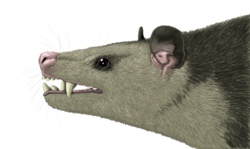Biology:Vincelestes
| Vincelestes | |
|---|---|

| |
| Artist's restoration | |
| Scientific classification | |
| Domain: | Eukaryota |
| Kingdom: | Animalia |
| Phylum: | Chordata |
| Class: | Mammalia |
| Clade: | Prototribosphenida |
| Family: | †Vincelestidae Bonaparte, 1986 |
| Genus: | †Vincelestes Bonaparte, 1986 |
| Species: | †V. neuquenianus
|
| Binomial name | |
| †Vincelestes neuquenianus Bonaparte, 1986
| |
Vincelestes ("Vince's thief") is an extinct genus of mammal that lived in what is now South America during the Early Cretaceous. It is closely related to modern therian mammals as part of Cladotheria.
Description
Vincelestes neuquenianus is the only species known to date. Specimens were found in La Amarga Formation of southern Neuquén Province, Argentina . The remains of only nine individuals were recovered from this site.[citation needed]
The back teeth of Vincelestes were similar to those of therians in that they were capable of cutting and grinding. This enabled them to process food more efficiently.[citation needed]
Diet
In one study on Mesozoic mammal mandibles, Vincelestes plots with herbivorous and omnivorous taxa.[1]
Phylogeny
Although not the direct ancestor of therians, Vincelestes is important because it gives an idea of what the ancestor of both placental and marsupial mammals might have looked like, and also gives an indication of when these mammals may have originated.[citation needed]
Some studies inversely recovered the genus as an australosphenida,[2][3] although current thought places Vincelestes as sister to marsupials and placental mammals.[4][5]
References
- ↑ Morales-García, N. M.; Gill, P. G.; Janis, C. M.; Rayfield, E. J. (2021). "Jaw shape and mechanical advantage are indicative of diet in Mesozoic mammals". Communications Biology 4 (1): 242. doi:10.1038/s42003-021-01757-3. PMID 33623117.
- ↑ Chimento, Nicolas; Agnolin, Federico; Martinelli, Agustin (May 2016). "Mesozoic Mammals from South America: Implications for understanding early mammalian faunas from Gondwana". Historia Evolutiva y Paleobiogeográfica de los Vertebrados de América del Sur. pp. 199–209. https://www.researchgate.net/publication/309431142.
- ↑ Bonaparte, José F. (17 September 2008). "On the phylogenetic relationships of". Historical Biology 20 (2): 81–86. doi:10.1080/08912960802164470.
- ↑ Huttenlocker, Adam K.; Grossnickle, David M.; Kirkland, James I.; Schultz, Julia A.; Luo, Zhe-Xi (23 May 2018). "Late-surviving stem mammal links the lowermost Cretaceous of North America and Gondwana". Nature 558 (7708): 108–112. doi:10.1038/s41586-018-0126-y. PMID 29795343. Bibcode: 2018Natur.558..108H.
- ↑ Bi, Shundong; Zheng, Xiaoting; Wang, Xiaoli; Cignetti, Natalie E.; Yang, Shiling; Wible, John R. (13 June 2018). "An Early Cretaceous eutherian and the placental–marsupial dichotomy". Nature 558 (7710): 390–395. doi:10.1038/s41586-018-0210-3. PMID 29899454. Bibcode: 2018Natur.558..390B.
Further reading
- Turner, A. (2004). National Geographic Prehistoric Mammals. Firecrest Books. p. 46.
- Kielan-Jaworowska, Z.; Cifelli, R.; Luo, Z. (2004). Mammals from the Age of Dinosaurs: Origins, Evolution, and Structure. Columbia University Press. p. 399. ISBN 9780231119184. https://archive.org/details/mammalsfromagedi00kiel_769.
External links
Wikidata ☰ Q4188998 entry
 |

